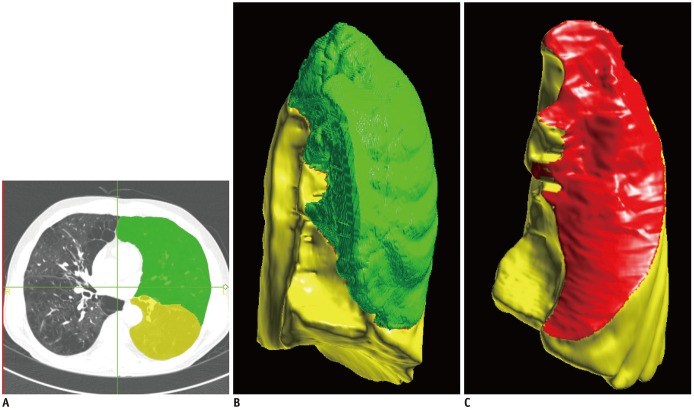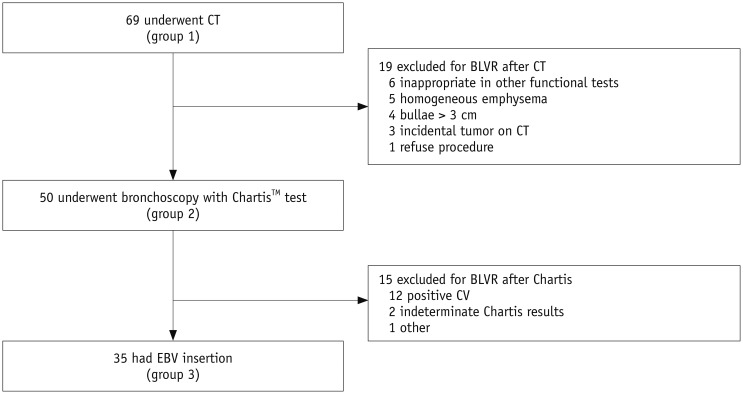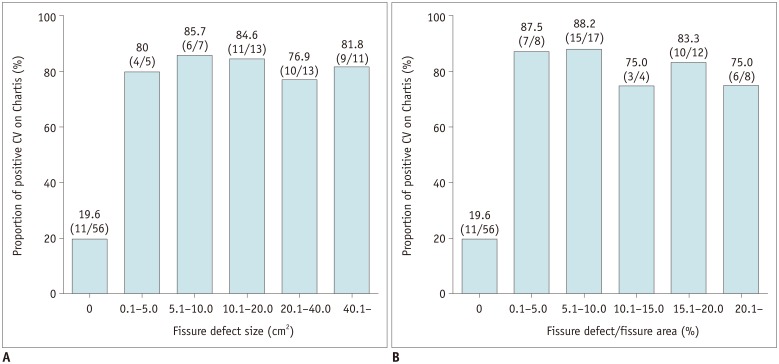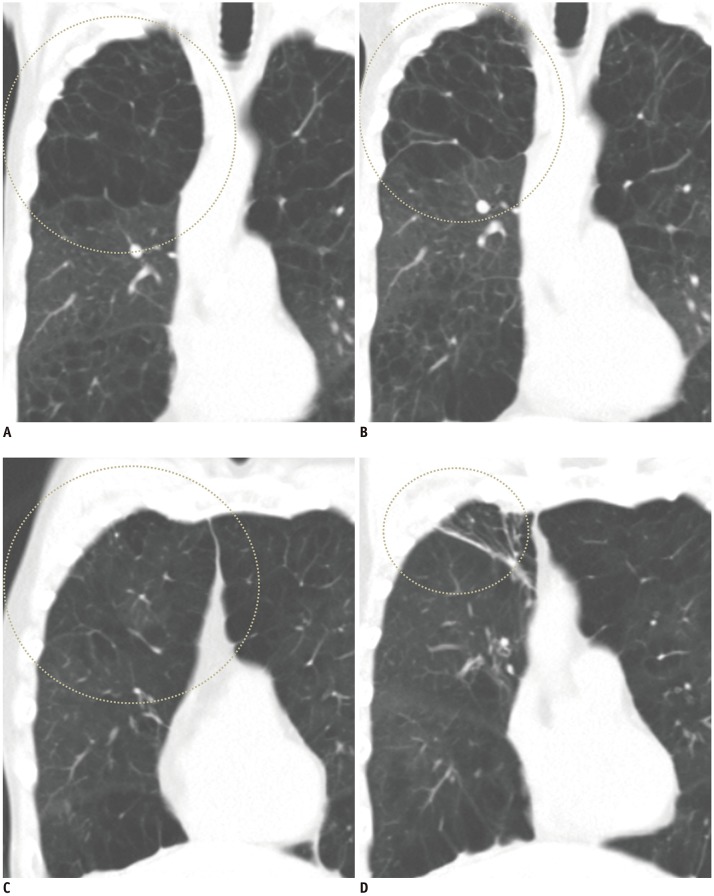Korean J Radiol.
2019 Jul;20(7):1216-1225. 10.3348/kjr.2018.0724.
Clinical Utility of Quantitative CT Analysis for Fissure Completeness in Bronchoscopic Lung Volume Reduction: Comparison between CT and Chartisâ„¢
- Affiliations
-
- 1Department of Pulmonary and Critical Care Medicine, and Clinical Research Center for Chronic Obstructive Airway Diseases, Asan Medical Center, University of Ulsan College of Medicine, Seoul, Korea.
- 2Department of Radiology and Research Institute of Radiology, Asan Medical Center, University of Ulsan College of Medicine, Seoul, Korea. asellion@hanmail.net
- 3Department of Radiology, Kyung Hee University Hospital, College of Medicine, Kyung Hee University, Seoul, Korea.
- 4Department of Radiology, Pusan National University Yangsan Hospital, Yangsan, Korea.
- 5Department of Radiology, University of Daegu Catholic College of Medicine, Daegu Catholic University Medical Center, Daegu, Korea.
- KMID: 2467032
- DOI: http://doi.org/10.3348/kjr.2018.0724
Abstract
OBJECTIVE
The absence of collateral ventilation (CV) is crucial for effective bronchoscopic lung volume reduction (BLVR) with an endobronchial valve. Here, we assessed whether CT can predict the Chartisâ„¢ results.
MATERIALS AND METHODS
This study included 69 patients (mean age: 70.9 ± 6.6 years; 66 [95.7%] males) who had undergone CT to assess BLVR eligibility. The Chartisâ„¢ system (Pulmonox Inc.) was used to check CV. Experienced thoracic radiologists independently determined the completeness of fissures on volumetric CT images.
RESULTS
The comparison between the visual and quantitative analyses revealed that 5% defect criterion showed good agreement. The Chartisâ„¢ assessment was performed for 129 lobes; 11 (19.6%) of 56 lobes with complete fissures on CT showed positive CV, while this rate was significantly higher (40 of 49 lobes, i.e., 81.6%) for lobes with incomplete fissures. The size of the fissure defect did not affect the rate of CV. Of the patients who underwent BLVR, 22 of 24 patients (91.7%) with complete fissures and three of four patients with incomplete fissures (75%) achieved target lobe volume reduction (TLVR).
CONCLUSION
The quantitative analysis of fissure shows that incomplete fissures increased the probability of CV on Chartisâ„¢, while the defect size did not affect the overall rates. TLVR could be achieved even in some patients with relatively large fissure defect, if they showed negative CV on Chartisâ„¢.
MeSH Terms
Figure
Reference
-
1. Vestbo J, Hurd SS, Agustí AG, Jones PW, Vogelmeier C, Anzueto A, et al. Global strategy for the diagnosis, management, and prevention of chronic obstructive pulmonary disease: GOLD executive summary. Am J Respir Crit Care Med. 2013; 187:347–365. PMID: 22878278.2. Mathers CD, Loncar D. Projections of global mortality and burden of disease from 2002 to 2030. PLoS Med. 2006; 3:e442. PMID: 17132052.
Article3. Calverley PM, Anderson JA, Celli B, Ferguson GT, Jenkins C, Jones PW, et al. TORCH investigators. Salmeterol and fluticasone propionate and survival in chronic obstructive pulmonary disease. N Engl J Med. 2007; 356:775–789. PMID: 17314337.
Article4. Tashkin DP, Celli B, Senn S, Burkhart D, Kesten S, Menjoge S, et al. UPLIFT Study Investigators. A 4-year trial of tiotropium in chronic obstructive pulmonary disease. N Engl J Med. 2008; 359:1543–1554. PMID: 18836213.
Article5. Lee JH, Lee YK, Kim EK, Kim TH, Huh JW, Kim WJ, et al. Responses to inhaled long-acting beta-agonist and corticosteroid according to COPD subtype. Respir Med. 2010; 104:542–549. PMID: 19926461.
Article6. Sciurba FC, Ernst A, Herth FJ, Strange C, Criner GJ, Marquette CH, et al. VENT Study Research Group. A randomized study of endobronchial valves for advanced emphysema. N Engl J Med. 2010; 363:1233–1244. PMID: 20860505.
Article7. Snell GI, Holsworth L, Borrill ZL, Thomson KR, Kalff V, Smith JA, et al. The potential for bronchoscopic lung volume reduction using bronchial prostheses: a pilot study. Chest. 2003; 124:1073–1080. PMID: 12970040.8. Wan IY, Toma TP, Geddes DM, Snell G, Williams T, Venuta F, et al. Bronchoscopic lung volume reduction for end-stage emphysema: report on the first 98 patients. Chest. 2006; 129:518–526. PMID: 16537847.9. Herth FJ, Eberhardt R, Gompelmann D, Ficker JH, Wagner M, Ek L, et al. Radiological and clinical outcomes of using Chartis™ to plan endobronchial valve treatment. Eur Respir J. 2013; 41:302–308. PMID: 22556025.
Article10. Herth FJ, Noppen M, Valipour A, Leroy S, Vergnon JM, Ficker JH, et al. International VENT Study Group. Efficacy predictors of lung volume reduction with Zephyr valves in a European cohort. Eur Respir J. 2012; 39:1334–1342. PMID: 22282552.
Article11. Park TS, Hong Y, Lee JS, Oh SY, Lee SM, Kim N, et al. Bronchoscopic lung volume reduction by endobronchial valve in advanced emphysema: the first Asian report. Int J Chron Obstruct Pulmon Dis. 2015; 10:1501–1511. PMID: 26251590.12. Klooster K, ten Hacken NH, Hartman JE, Kerstjens HA, van Rikxoort EM, Slebos DJ. Endobronchial valves for emphysema without interlobar collateral ventilation. N Engl J Med. 2015; 373:2325–2335. PMID: 26650153.
Article13. Lee SW, Lee SM, Shin SY, Park TS, Oh SY, Kim N, et al. Improvement in ventilation-perfusion mismatch after bronchoscopic lung volume reduction: quantitative image analysis. Radiology. 2017; 285:250–260. PMID: 28510483.
Article14. Valipour A, Herth FJ, Burghuber OC, Criner G, Vergnon JM, Goldin J, et al. VENT Study Group. Target lobe volume reduction and COPD outcome measures after endobronchial valve therapy. Eur Respir J. 2014; 43:387–396. PMID: 23845721.
Article15. Shah PL, Herth FJ. Current status of bronchoscopic lung volume reduction with endobronchial valves. Thorax. 2014; 69:280–286. PMID: 24008689.
Article16. Reymond E, Jankowski A, Pison C, Bosson JL, Prieur M, Aniwidyaningsih W, et al. Prediction of lobar collateral ventilation in 25 patients with severe emphysema by fissure analysis with CT. AJR Am J Roentgenol. 2013; 201:W571–W575. PMID: 24059394.
Article17. Slebos DJ, Shah PL, Herth FJ, Valipour A. Endobronchial valves for endoscopic lung volume reduction: best practice recommendations from expert panel on endoscopic lung volume reduction. Respiration. 2017; 93:138–150. PMID: 27992862.
Article18. Gompelmann D, Eberhardt R, Herth FJ. Collateral ventilation. Respiration. 2013; 85:515–520. PMID: 23485627.
Article19. Shah PL, Herth FJ. Dynamic expiratory airway collapse and evaluation of collateral ventilation with Chartis. Thorax. 2014; 69:290–291. PMID: 24355826.
Article20. de Oliveira HG, de Oliveira SM, Rambo RR, de Macedo Neto AV. Fissure integrity and volume reduction in emphysema: a retrospective study. Respiration. 2016; 91:471–479. PMID: 27241515.
Article21. Gompelmann D, Eberhardt R, Slebos DJ, Brown MS, Abtin F, Kim HJ, et al. Diagnostic performance comparison of the Chartis System and high-resolution computerized tomography fissure analysis for planning endoscopic lung volume reduction. Respirology. 2014; 19:524–530. PMID: 24612306.
Article22. Venuta F, Anile M, Diso D, Carillo C, De Giacomo T, D'Andrilli A, et al. Long-term follow-up after bronchoscopic lung volume reduction in patients with emphysema. Eur Respir J. 2012; 39:1084–1089. PMID: 22005916.
Article23. Gompelmann D, Eberhardt R, Michaud G, Ernst A, Herth FJ. Predicting atelectasis by assessment of collateral ventilation prior to endobronchial lung volume reduction: a feasibility study. Respiration. 2010; 80:419–425. PMID: 20664194.
Article24. Gesierich W, Samitas K, Reichenberger F, Behr J. Collapse phenomenon during Chartis collateral ventilation assessment. Eur Respir J. 2016; 47:1657–1667. PMID: 27076587.
Article25. Davey C, Zoumot Z, Jordan S, McNulty WH, Carr DH, Hind MD, et al. Bronchoscopic lung volume reduction with endobronchial valves for patients with heterogeneous emphysema and intact interlobar fissures (the BeLieVeR-HIFi study): a randomised controlled trial. Lancet. 2015; 386:1066–1073. PMID: 26116485.
Article26. Fiorelli A, Santini M, Shah P. When can computed tomography-fissure analysis replace Chartis collateral ventilation assessment in the prediction of patients with emphysema who might benefit from endobronchial valve therapy? Interact Cardiovasc Thorac Surg. 2018; 26:313–318. PMID: 29049667.
Article27. Schuhmann M, Raffy P, Yin Y, Gompelmann D, Oguz I, Eberhardt R, et al. Computed tomography predictors of response to endobronchial valve lung reduction treatment. Comparison with Chartis. Am J Respir Crit Care Med. 2015; 191:767–774. PMID: 25635349.
Article28. Valipour A, Slebos DJ, Herth F, Darwiche K, Wagner M, Ficker JH, et al. IMPACT Study Team. Endobronchial valve therapy in patients with homogeneous emphysema. Results from the IMPACT study. Am J Respir Crit Care Med. 2016; 194:1073–1082. PMID: 27580428.
Article29. Davey C, Zoumot Z, Jordan S, Carr DH, Polkey MI, Shah PL, et al. Bronchoscopic lung volume reduction with endobronchial valves for patients with heterogeneous emphysema and intact interlobar fissures (the BeLieVeR-HIFi trial): study design and rationale. Thorax. 2015; 70:288–290. PMID: 24664535.
Article30. Desplechain C, Foliguet B, Barrat E, Grignon G, Touati F. [The pores of Kohn in pulmonary alveoli]. Bull Eur Physiopathol Respir. 1983; 19:59–68. PMID: 6850150.31. Cotes JE, Chinn DJ, Miller MR. Lung function: physiology, measurement and application in medicine. Malden, MA: Blackwell Publishing Ltd;2006. p. 27.
- Full Text Links
- Actions
-
Cited
- CITED
-
- Close
- Share
- Similar articles
-
- A study on the anatomical morphology of the minor fissure
- The Fissural Complex of the Lung: Anatomy and Variations on Thin-Section CT Scans
- Use of Quantitative CT to Predict Postoperative Lung Function (Comparison of Quantitative CT and Perfusion Lung Scan)
- Inferior Accessory Fissure on Multi-Detector CT Image
- Clinical Applications of Bronchoscopic Lung Volume Reduction for Patients with Severe Emphysema





